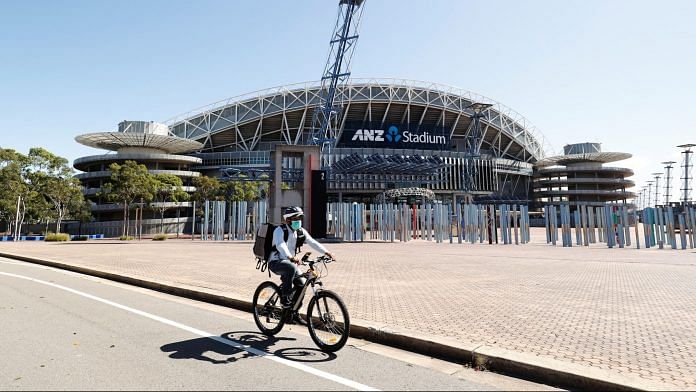Canberra: Six weeks after shutting down swathes of the economy to contain the coronavirus, Australia is preparing to relax its lockdown on Friday. There could be a cost — new clusters of infections just as the southern hemisphere heads into winter.
Closing restaurants, cinemas and pubs and urging people to largely stay at home have seen the daily rate of new infections plunge to less than 0.5% from 20% about a month ago. Along with extensive testing and contact tracing, the restrictions have bought Australia’s health system time to prepare for new outbreaks, as Prime Minister Scott Morrison looks to reboot the crippled economy.
The country of 25.7 million people, which had recorded 6,875 cases and 97 deaths as of Wednesday, will be among the first developed nations to test the resilience of its health system by lifting restrictions just as the weather turns colder. Morrison, who’s heralded his government’s success in flattening the curve, says the health system is in a good position to cope as he now turns to resuscitating the economy.
“When we move and start to ease some of these restrictions, of course you will see numbers increase in some areas, you will see outbreaks occur in other places,” Morrison told reporters this week. “What matters is how you deal with it, and how you respond to it.”
While seasonal flu often flares in winter in temperate climates, scientists are still investigating whether temperature plays a role in the coronavirus outbreak. Australia’s experience may offer clues to what may happen a few months from now in the northern winter.
‘Best Position’
Australia has so far avoided the scale of sickness and death that’s ravaged countries including the U.K., U.S. and Italy. Peter Collignon, an infectious diseases physician and professor at the Australian National University Medical School, says Australia’s handling of the outbreak has put it in “probably the best position in the world.”
“We closed borders very early, have had strong quarantine measures, traced just about every case and convinced the vast majority of Australians to adhere to social-distancing restrictions,” Collignon said. “Of course, the virus hasn’t been eliminated, so we need to avoid thinking things will quickly return to business as usual.”
In late January, Morrison announced the first of a string of border controls and enforced quarantine measures to limit and test arrivals from virus hotspots. He closed the nation to non-residents on March 19. Most Australian states and territories also imposed their own border restrictions.
Health authorities have ramped up testing and contact tracing. According to World Economic Forum data, as of April 26 the nation had conducted 19.9 diagnostic tests for Covid-19 per 1,000 people, compared with 15.6 tests in the U.S., 9.9 tests in the U.K and 1.8 in Japan. Some 5 million people have downloaded mobile-phone software designed to help trace coronavirus infections, though the government says that’s still not enough for it to be effective.
In the past six weeks, Australia has also ramped up the number of intensive-care unit beds, most of which are currently idle. Initial shortfalls of personal protection and medical equipment have, in the main, been identified and alleviated.
According to Collignon, the island continent has also benefited from its geographic isolation and the fact that its population mainly lives in suburban or regional areas, rather than in crowded cities. Still, he’s urging the government to not wind back social-distancing restrictions, particularly for mass gatherings, until after winter.
“There’s some basic principles that we can’t compromise too much, particularly as winter is coming, because there’s a risk that this will jump up and bite us again,” he said.
Also read: Testosterone-reducing hormone therapy could help protect men against Covid: Italian study
Economic Toll
At the heart of Australia’s early success has been the cooperation between Morrison’s federal government and the eight state and territory governments, which have put aside political rivalries to largely work in unison. Some states, which have seen days without new infections, have already started to relax social-distancing measures — allowing picnics, water sports, hiking in national parks and reopening schools.
But there have been missteps. The most populous state of New South Wales and federal authorities fell into a blame game over why thousands of passengers were allowed to disembark the Ruby Princess cruise ship in Sydney in March, even through 13 people on board suffered flu-like symptoms. Hundreds of cases across the nation and at least 20 deaths have been linked to the cruise ship.
The lockdown has taken a heavy economic toll: unemployment is poised to double by July to about 10% and the nation is veering toward its first recession in almost three decades. With restrictions costing the economy an estimated A$4 billion ($2.4 billion) a week, Morrison is keen to relax measures and has been drafting “Covid-safe” guidelines to help businesses return to work.
But the risks are clear. A cluster of almost 50 cases at a meat processing plant in Victoria state is a reminder of how outbreaks can emerge and potentially get out of hand, particularly with winter approaching.
“It’s a very sobering reminder that if the government and the private sector want to get the economy back to some kind of normality, it will probably come at a cost,” said Mary-Louise McLaws, an infectious diseases expert at the University of New South Wales.-Bloomberg
Also read: WHO wants to go to China again as search for origin of coronavirus heats up






